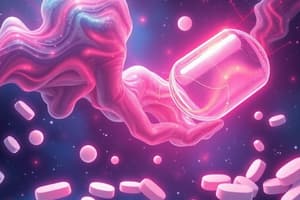Podcast
Questions and Answers
Which of the following best describes the mechanism of action of pyrantel pamoate?
Which of the following best describes the mechanism of action of pyrantel pamoate?
According to the content provided, what is a key concern when using antacids relating to drug interactions?
According to the content provided, what is a key concern when using antacids relating to drug interactions?
What is the maximum dose of pyrantel base that should be administered to a child or adult, according to the provided text?
What is the maximum dose of pyrantel base that should be administered to a child or adult, according to the provided text?
What is the primary mechanism of action for azole antifungals, such as clotrimazole, miconazole, and tioconazole, in treating vulvovaginal candidiasis?
What is the primary mechanism of action for azole antifungals, such as clotrimazole, miconazole, and tioconazole, in treating vulvovaginal candidiasis?
Signup and view all the answers
Which of the following is true regarding the interaction between codeine and dextromethorphan based on the content provided?
Which of the following is true regarding the interaction between codeine and dextromethorphan based on the content provided?
Signup and view all the answers
Which of the following best describes the effect of CYP2D6 inhibitors on codeine?
Which of the following best describes the effect of CYP2D6 inhibitors on codeine?
Signup and view all the answers
Why does dextromethorphan not have analgesic properties, unlike codeine?
Why does dextromethorphan not have analgesic properties, unlike codeine?
Signup and view all the answers
Which of the following is the primary pharmacological action of guaifenesin?
Which of the following is the primary pharmacological action of guaifenesin?
Signup and view all the answers
A patient with mild renal impairment is prescribed calcium carbonate as an antacid. What might be a potential concern with long term use?
A patient with mild renal impairment is prescribed calcium carbonate as an antacid. What might be a potential concern with long term use?
Signup and view all the answers
Which medication is known to cause antiandrogenic effects, such as decreased libido and gynecomastia in men?
Which medication is known to cause antiandrogenic effects, such as decreased libido and gynecomastia in men?
Signup and view all the answers
Which of the following medications would have an interaction with citalopram due to its inhibition of the CYP2C19 enzyme?
Which of the following medications would have an interaction with citalopram due to its inhibition of the CYP2C19 enzyme?
Signup and view all the answers
What is the approximate onset of action for H2 receptor antagonists such as famotidine?
What is the approximate onset of action for H2 receptor antagonists such as famotidine?
Signup and view all the answers
Concurrent use of which medication class alongside dextromethorphan is most likely to increase the risk of serotonergic effects?
Concurrent use of which medication class alongside dextromethorphan is most likely to increase the risk of serotonergic effects?
Signup and view all the answers
Acetaminophen's mechanism of action involves which detoxification process?
Acetaminophen's mechanism of action involves which detoxification process?
Signup and view all the answers
A patient with a history of a bleeding disorder should not take which of the following medications?
A patient with a history of a bleeding disorder should not take which of the following medications?
Signup and view all the answers
Which of the following medications poses the highest risk of hypertension when used with linezolid?
Which of the following medications poses the highest risk of hypertension when used with linezolid?
Signup and view all the answers
Which of the following is a common side effect associated with first-generation antihistamines such as diphenhydramine?
Which of the following is a common side effect associated with first-generation antihistamines such as diphenhydramine?
Signup and view all the answers
Which second-generation antihistamine is known for causing the most sedation?
Which second-generation antihistamine is known for causing the most sedation?
Signup and view all the answers
Intranasal corticosteroids like fluticasone work by inhibiting multiple cell types and mediators, impacting which of the following processes?
Intranasal corticosteroids like fluticasone work by inhibiting multiple cell types and mediators, impacting which of the following processes?
Signup and view all the answers
A deficiency in which of the following vitamins is a contraindication for aspirin use?
A deficiency in which of the following vitamins is a contraindication for aspirin use?
Signup and view all the answers
The use of intranasal corticosteroids over a long period of time has been linked with what potential adverse effect?
The use of intranasal corticosteroids over a long period of time has been linked with what potential adverse effect?
Signup and view all the answers
Which medication must be used one week prior to allergen exposure to be considered effective?
Which medication must be used one week prior to allergen exposure to be considered effective?
Signup and view all the answers
Codeine's antitussive action primarily occurs through its effect on which part of the brain?
Codeine's antitussive action primarily occurs through its effect on which part of the brain?
Signup and view all the answers
Which of the following best describes the primary function of ergosterol?
Which of the following best describes the primary function of ergosterol?
Signup and view all the answers
For pregnant women experiencing vaginal itching and irritation, which of the following treatment durations is generally advised?
For pregnant women experiencing vaginal itching and irritation, which of the following treatment durations is generally advised?
Signup and view all the answers
An individual experiencing overactive bladder is prescribed oxybutynin patches. What is the primary mechanism of action of this medication?
An individual experiencing overactive bladder is prescribed oxybutynin patches. What is the primary mechanism of action of this medication?
Signup and view all the answers
A topical analgesic product contains 2-16% menthol and 3.2% camphor. What sensation is typically expected from the application of this product?
A topical analgesic product contains 2-16% menthol and 3.2% camphor. What sensation is typically expected from the application of this product?
Signup and view all the answers
Which vitamin deficiency is most closely associated with macrocytic anemia?
Which vitamin deficiency is most closely associated with macrocytic anemia?
Signup and view all the answers
Folic acid is crucial for preventing which condition?
Folic acid is crucial for preventing which condition?
Signup and view all the answers
Which vitamin, when used topically can help minimize the appearance of scars?
Which vitamin, when used topically can help minimize the appearance of scars?
Signup and view all the answers
Besides heart health, Coenzyme Q10 is also useful in what condition?
Besides heart health, Coenzyme Q10 is also useful in what condition?
Signup and view all the answers
A patient with a diagnosis of hypertriglyceridemia asks about supplements. Which would be the most suitable product to recommend?
A patient with a diagnosis of hypertriglyceridemia asks about supplements. Which would be the most suitable product to recommend?
Signup and view all the answers
Which of the following is paired correctly?
Which of the following is paired correctly?
Signup and view all the answers
Which herbal supplement is primarily associated with the treatment of depression, anxiety, and OCD?
Which herbal supplement is primarily associated with the treatment of depression, anxiety, and OCD?
Signup and view all the answers
What is a significant adverse effect associated with the use of Kava?
What is a significant adverse effect associated with the use of Kava?
Signup and view all the answers
Which group of supplements are known for potentially reducing the duration of colds?
Which group of supplements are known for potentially reducing the duration of colds?
Signup and view all the answers
What is the primary function of probiotics?
What is the primary function of probiotics?
Signup and view all the answers
Which of the following is a primary therapeutic use of Saw Palmetto?
Which of the following is a primary therapeutic use of Saw Palmetto?
Signup and view all the answers
Black cohosh is primarily used for which of the following?
Black cohosh is primarily used for which of the following?
Signup and view all the answers
Evening primrose oil is primarily used to manage which conditions?
Evening primrose oil is primarily used to manage which conditions?
Signup and view all the answers
Based on the information available, with which type of drugs are interactions most likely to occur?
Based on the information available, with which type of drugs are interactions most likely to occur?
Signup and view all the answers
According to gastroenterologists, what kind of probiotics are preferred?
According to gastroenterologists, what kind of probiotics are preferred?
Signup and view all the answers
A patient presents with symptoms of BPH. Which of these herbal supplements should be considered?
A patient presents with symptoms of BPH. Which of these herbal supplements should be considered?
Signup and view all the answers
Flashcards
Acetaminophen (APAP)
Acetaminophen (APAP)
A common analgesic used for mild-moderate pain and fever reduction. Metabolized by CYP450 and detoxified by glutathione during Phase II conjugation.
NSAIDs
NSAIDs
A group of drugs that inhibit prostaglandin synthesis from arachidonic acid by blocking both COX-1 and COX-2 enzymes.
Acetylcysteine
Acetylcysteine
An antidote used to treat acetaminophen overdose.
Pseudoephedrine
Pseudoephedrine
Signup and view all the flashcards
1st Generation Antihistamines
1st Generation Antihistamines
Signup and view all the flashcards
2nd Generation Antihistamines
2nd Generation Antihistamines
Signup and view all the flashcards
Intranasal Corticosteroids
Intranasal Corticosteroids
Signup and view all the flashcards
Cromolyn Sodium
Cromolyn Sodium
Signup and view all the flashcards
Codeine
Codeine
Signup and view all the flashcards
Mast Cell Stabilizers
Mast Cell Stabilizers
Signup and view all the flashcards
Codeine Metabolism
Codeine Metabolism
Signup and view all the flashcards
Codeine Over-metabolism
Codeine Over-metabolism
Signup and view all the flashcards
Dextromethorphan: How it works
Dextromethorphan: How it works
Signup and view all the flashcards
Dextromethorphan Drug Interactions
Dextromethorphan Drug Interactions
Signup and view all the flashcards
Guaifenesin: Expectorant
Guaifenesin: Expectorant
Signup and view all the flashcards
Antacids
Antacids
Signup and view all the flashcards
H2 Receptor Blockers
H2 Receptor Blockers
Signup and view all the flashcards
Proton Pump Inhibitors (PPIs)
Proton Pump Inhibitors (PPIs)
Signup and view all the flashcards
What is a prodrug?
What is a prodrug?
Signup and view all the flashcards
How does stomach pH impact drug interactions?
How does stomach pH impact drug interactions?
Signup and view all the flashcards
How does Pyrantel pamoate (Pin-X) treat pinworms?
How does Pyrantel pamoate (Pin-X) treat pinworms?
Signup and view all the flashcards
Compare codeine and dextromethorphan.
Compare codeine and dextromethorphan.
Signup and view all the flashcards
What are the maximum daily dosages of acetaminophen, ibuprofen, and naproxen for adults and pediatrics?
What are the maximum daily dosages of acetaminophen, ibuprofen, and naproxen for adults and pediatrics?
Signup and view all the flashcards
Ergosterol
Ergosterol
Signup and view all the flashcards
Hydrocortisone 1%
Hydrocortisone 1%
Signup and view all the flashcards
Benzocaine 5 to 10%
Benzocaine 5 to 10%
Signup and view all the flashcards
Oxybutynin patches
Oxybutynin patches
Signup and view all the flashcards
Anti-muscarinic drugs
Anti-muscarinic drugs
Signup and view all the flashcards
Overactive bladder
Overactive bladder
Signup and view all the flashcards
Anemia
Anemia
Signup and view all the flashcards
Macrocytic anemia
Macrocytic anemia
Signup and view all the flashcards
Microcytic anemia
Microcytic anemia
Signup and view all the flashcards
Osteoporosis
Osteoporosis
Signup and view all the flashcards
St. John's Wort
St. John's Wort
Signup and view all the flashcards
Kava
Kava
Signup and view all the flashcards
Echinacea
Echinacea
Signup and view all the flashcards
Sambucus Nigra (Elderberry)
Sambucus Nigra (Elderberry)
Signup and view all the flashcards
Probiotics
Probiotics
Signup and view all the flashcards
Saw Palmetto
Saw Palmetto
Signup and view all the flashcards
Black Cohosh
Black Cohosh
Signup and view all the flashcards
Evening Primrose Oil
Evening Primrose Oil
Signup and view all the flashcards
Herbal Supplement Interactions
Herbal Supplement Interactions
Signup and view all the flashcards
Herbal Supplements vs. Conventional Medicine
Herbal Supplements vs. Conventional Medicine
Signup and view all the flashcards
Evidence for Herbal Supplements
Evidence for Herbal Supplements
Signup and view all the flashcards
Study Notes
Analgesics and Antipyretics
- APAP (Acetaminophen): Metabolized by CYP450 and detoxified by glutathione (Phase II conjugation).
- Adverse effects in adults: nausea, vomiting, headache, insomnia. Adverse effects in children: nausea, vomiting, constipation, pruritus, agitation. Hepatotoxicity is associated with acute liver failure, sometimes resulting in liver failure or death. Injury occurs when the recommended maximum daily limit is exceeded.
- Acetylcysteine is the antidote.
Nonsteroidal Anti-inflammatory Drugs (NSAIDs)
- Adverse effects: gastrointestinal ulcers, perforation, bleeding, increased risk of myocardial infarction (MI), heart failure (HF), hypertension (HTN), stroke, sodium and water retention causing edema.
- Methotrexate clearance is decreased.
- P2Y12 inhibitors and SSRIs increase the risk of bleeding.
- Bisphosphonates increase the risk of gastrointestinal bleeding and ulcers.
Anti-inflammatory Drugs
- ASA (Acetylsalicylic Acid): Inhibits prostaglandin synthesis from arachidonic acid by inhibiting both isoforms of the COX enzyme (COX-1 and COX-2). Contraindicated in patients with vitamin K deficiency, bleeding disorders, or children with influenza or chicken pox (due to Reye's syndrome risk). Similar to NSAIDs.
- Similar to NSAIDs. Valproic acid displacement from protein binding sites and inhibition of valproic metabolism is noted.
- Sulfonylureas increase the risk of hypoglycemia.
Antihistamines
- Diphenhydramine (1st gen): Sedating. Competes with histamine at central and peripheral histamine type 1 receptor sites, preventing histamine receptor interaction and subsequent mediator release.
- Chlorpheniramine: Same mechanism as diphenhydramine.
- Doxylamine: Same mechanism as diphenhydramine and chlorpheniramine.
- Loratadine (2nd gen): Non-sedating. Inhibits release of mediators like histamine.
- Cetirizine (2nd gen): Non-sedating. Inhibits release of mediators.
Other Drugs
- Pseudoephedrine/Sudafed: Decongestant. Acts as a direct binding and displacement of norepinephrine from storage.
Corticosteroids
- Budesonide, Fluticasone, Triamcinolone (intranasal corticosteroids): Inhibit multiple cell types and mediators, including histamine.
Mast Cell Stabilizers
- Cromolyn sodium: Mast cell stabilizer used to prevent exposure to allergens, blocks calcium influx into mast cells.
Opioid Analgesics
- Codeine: Prodrug. Metabolized to morphine by CYP2D6.
- Dextromethorphan: Active compound, not a prodrug. Metabolized by CYP2D6. A cough suppressant.
- CYP2D6 interactions are important to note for both drugs.
Other OTC Medications
- Guaifenesin (Mucinex): Expectorant/loosens respiratory secretions.
- Mucinex D (guaifenesin + pseudoephedrine): Combination product.
- Mucinex DM (guaifenesin + dextromethorphan): Combination product.
- Antacids (for example: Aluminum-based and magnesium-based antacids).
- Cimetidine, Famotidine, Omeprazole, Esomeprazole, Lansoprazole. Proton Pump Inhibitors (PPIs).
- Pyrantel pamoate (Pin-X): Treats pinworms.
Other
- Echinacea, Sambucus nigra (elderberry), vitamin C, prophylactic and treatment of colds, can reduce the length of infection.
- Probiotics: Gastrointestinal flora restoration.
- Saw Palmetto, Black Cohosh, Evening primrose oil: Used for various conditions, primarily in women.
- Important: Drug interactions are possible with antidepressants and blood thinners.
Other specifics
- OTC drugs are mentioned—it's important to review specific dosage recommendations for various age groups as noted in the text.
Additional Notes from the Text
- Various interactions are mentioned—interactions with other drugs should be referenced when considering use of these drugs to avoid adverse outcomes.
Studying That Suits You
Use AI to generate personalized quizzes and flashcards to suit your learning preferences.
Related Documents
Description
This quiz covers key concepts regarding analgesics, antipyretics, and anti-inflammatory drugs, including their metabolism, adverse effects, and interactions. Understand the implications of drug overdose and the use of antidotes, specifically acetylcysteine for acetaminophen toxicity. Assess your knowledge of nonsteroidal anti-inflammatory drugs (NSAIDs) and their potential complications.




